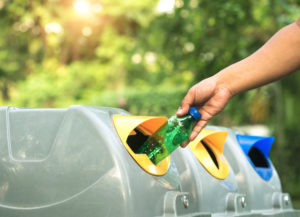
Blog
Saving Recycling with Arizona State University: Part 1
This interview is offered in two parts. Read part two.
Recycling is at a crossroads in America. With systems shutting down or limiting what they can accept in counties around the country, and accepted recyclables ending up where they shouldn’t — in landfills or worse, our oceans — action must be taken today, to save our planet tomorrow.
The Consumer Brands Association’s Recycling Leadership Council (RLC) is aiming to do just that. By uniting critical stakeholders across the packaging ecosystem, the diverse members of the RLC are working together to find a solution to the packaging waste crisis and build a public policy foundation for a 21st century recycling system in the United States.
Alicia Marseille and Rajesh Buch, from Arizona State University, make up part of this diverse group, focused on saving recycling in America. Marseille, who serves as director of innovation at the Rob and Melani Walton Sustainability Solutions Service, and Buch, the director of sustainability practice and international development at ASU, sat down with the Consumer Brands team to answer some questions about their work and the future of recycling.
ASU is a leader on systems thinking and sustainability. How can we use systems thinking to redesign not only our recycling system, but the entire packaging value chain? What does the perfect system look like utilizing systems thinking? What are some of the barriers you see?
A system is a set of interconnected parts organized within a defined boundary to provide functionality or utility. One of the immediate challenges in system design comes from defining a boundary, and then assuming everything external to the boundary is irrelevant to the system.
Systems thinking involves understanding the components, stakeholders, knowledge, policies and regulations, patterns and relationships that make up the packaging value chain. Since packaging comes in hundreds of combinations of materials and fabrication processes, there is no single answer to the “perfect” system – the answer lies in utilizing a holistic, systematic approach to evaluating and redesigning packaging systems.
A systemic approach requires coordinated, interdependent solutions in all aspects of the value chain, which in turn requires the concerted effort from a broad range of stakeholders that work to create enabling conditions for effective collaborations among institutions, industries, and regions. Effective collaboration in the future will be founded on purpose-driven systems transformation that result in collective impact.
Like many of the efforts ASU has worked on, the packaging and recycling value chains are complex systems that rely on each stakeholder to play their unique role. As we start to develop policy mechanisms with the collective goal of reducing the amount of packaging that ends up in landfill, where in the system should we target those efforts? Where are interventions particularly needed now? How can we ensure that our interventions don’t have unintended impacts?
The first, and maybe most critical step, comes in comprehensively understanding the most impactful plastic packaging value chains. This requires pre-competitive, industry-wide information and data sharing to understand where in the system these impacts occur and which policies or regulations affect those impacts. There are also challenges related to understanding the current landscape, including a lack of data availability and standardizations across product design protocols, resource extraction and processing, value chains, manufacturing processes and municipal waste management systems.
Further compounding these aspects, is the fact that the entire system is highly dynamic – most value chains are ever-evolving as companies compete for markets; policies are adjusted at the international, national and local levels; consumer demands are growing and shifting globally. This knowledge will identify barriers, opportunities and challenges for innovative solutions and where in the system to intervene.
Developing pilot programs would be an effective intervention, and would enable system wide solutions to be tested and understood. These pilots would enable stakeholders to understand the potential implications and unintended impacts of policies, technology based interventions or even system redesigns.
The Resource Innovation and Solutions Network (RISN) through Rob and Melani Walton Sustainability Solutions Services in partnership with the city of Phoenix’s Reimagine Phoenix initiative is a global network of public and private partners to create economic value from waste. What can the RLC learn from the collaboration, research, innovation and application of technologies from this program?
Over six years the Resource and Innovations Solutions Network (RISN) engaged with public and private sector stakeholders to transform the Phoenix region from simply managing solid waste to creating inclusive circular economies. Our holistic, inclusive circular economy framework aims to empower communities with the opportunity to become entrepreneur-producers using waste resources. Our solution is built on the principles of systems transformation and has the following basic pillars: 1) foster collaborative cross-sector networks of stakeholders to understand the landscape (value chains and resources) to enable inclusion and success; 2) establish and support innovative business, enterprise and institutional models; 3) provide access, technical skills development and capacity building for entrepreneurship; and 4) provide access to technologies and markets to prototype, pilot and manufacture upcycled products, within a local, decentralized and distributed collection, processing and production environment.
What technologies or tools do you see as necessary to create a 21st century recycling system? Do they exist yet?
Based on our RISN work, it became evident that stakeholders did not have enough information to drive system level change. The most powerful technology and tools involved comprehensively understanding the system as it currently operates and identifying opportunities for intervention, including geospatial analysis, network analysis, policy and institutional analysis, material flow mapping and more. These tools and technologies can be used to run various scenarios and develop compelling real-time visualizations for effective decision making using ASU’s Decision Theater.
Examples of system transformation include LOOP Industries, the Oregon Beverage Recycling Cooperative, Phillips and Interface. These organizations and collaborations started with pilots that are now being scaled but are founded on a better understanding of current practices and identifying places to intervene or completely redesign their systems.
Published on July 23, 2020




